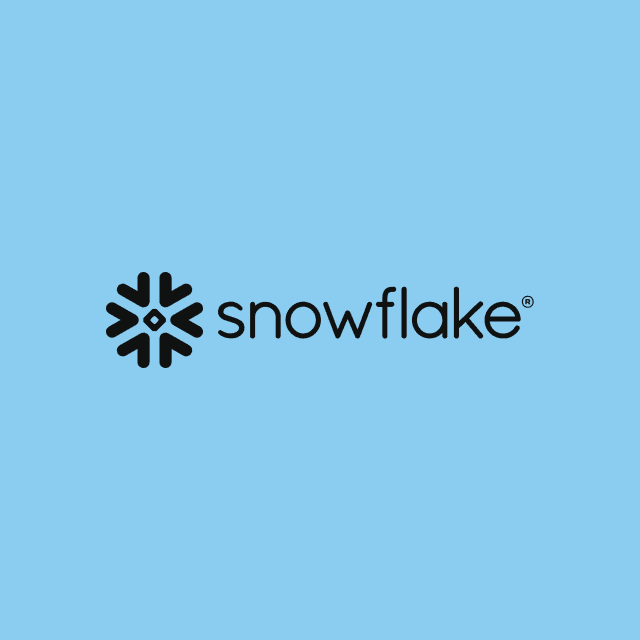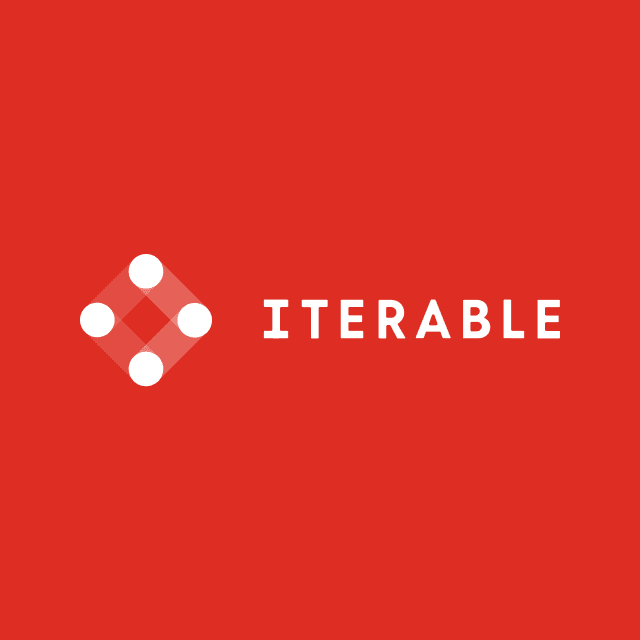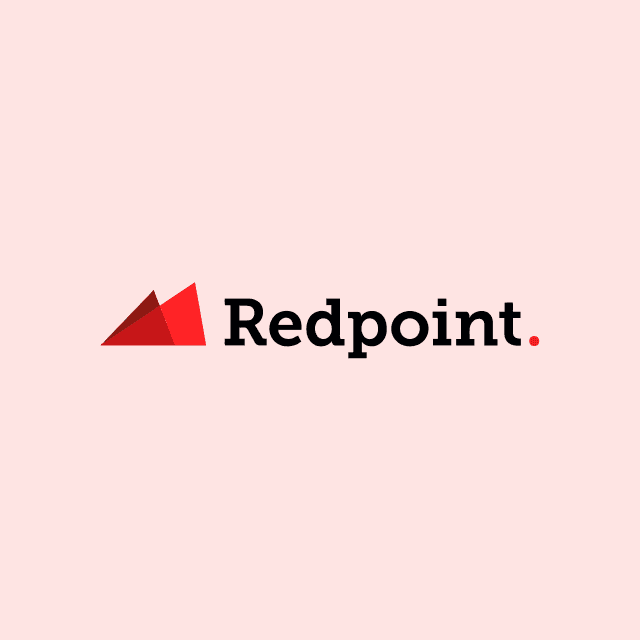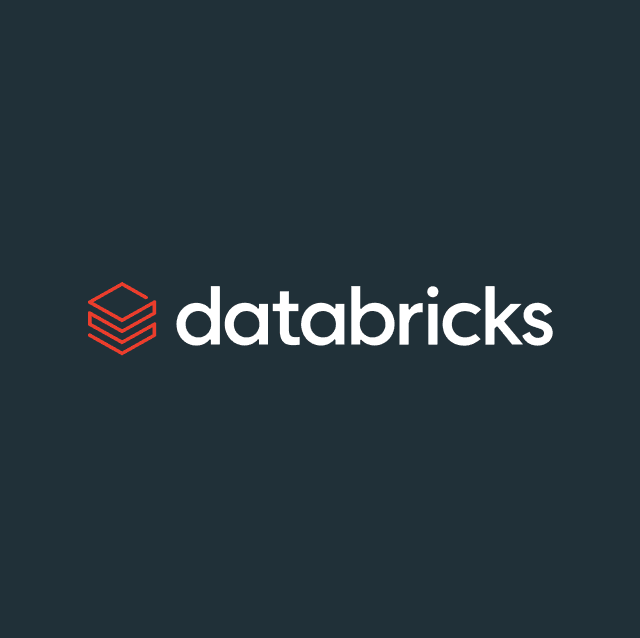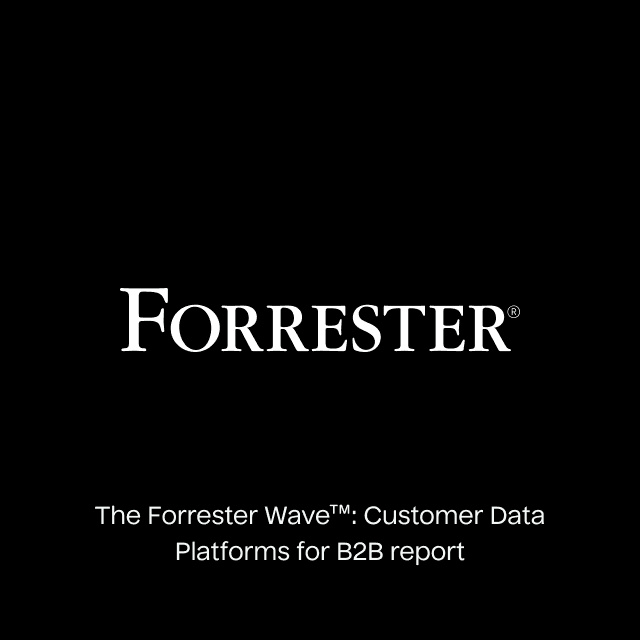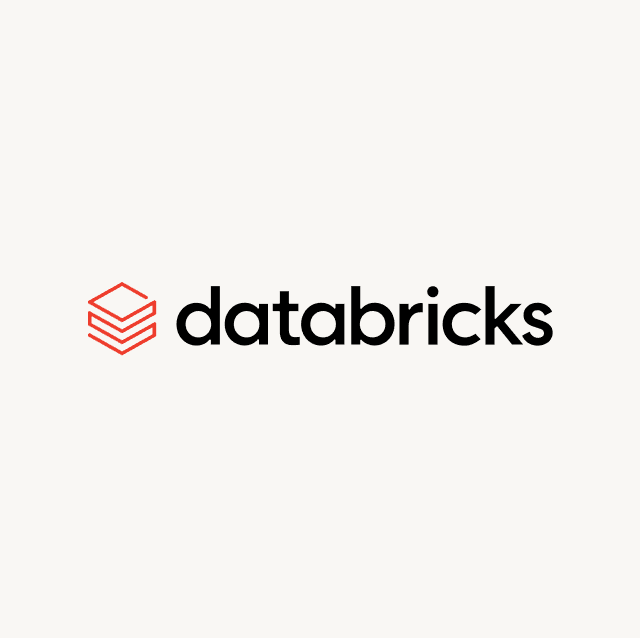As privacy regulations evolve and traditional tracking methods become less reliable, advertisers face increasing challenges in accurately measuring conversions and optimizing campaign results. Browser-based tools like tracking pixels are often blocked by ad blockers, restricted by browser privacy settings, or disrupted by network issues, leading to underreported performance and lost revenue opportunities.
The Bing Conversions API solves these problems by enabling direct, server-to-server delivery of conversion data, giving you complete control over the data pipeline and improving reliability. With this API, you can bypass browser limitations and send complete, high-quality conversion events, online or offline, directly to Bing. This leads to better attribution, smarter bidding decisions, and a higher return on ad spend (ROAS).
In this guide, you’ll learn how to set up the Bing Conversions API in just a few steps using your existing customer and event data. Whether you’re tracking purchases, form submissions, or offline leads, Bing’s server-side integration helps you maintain measurement accuracy and optimize for the outcomes that matter most to your business.
How to set up Bing conversion API?
1. Connect to your data source
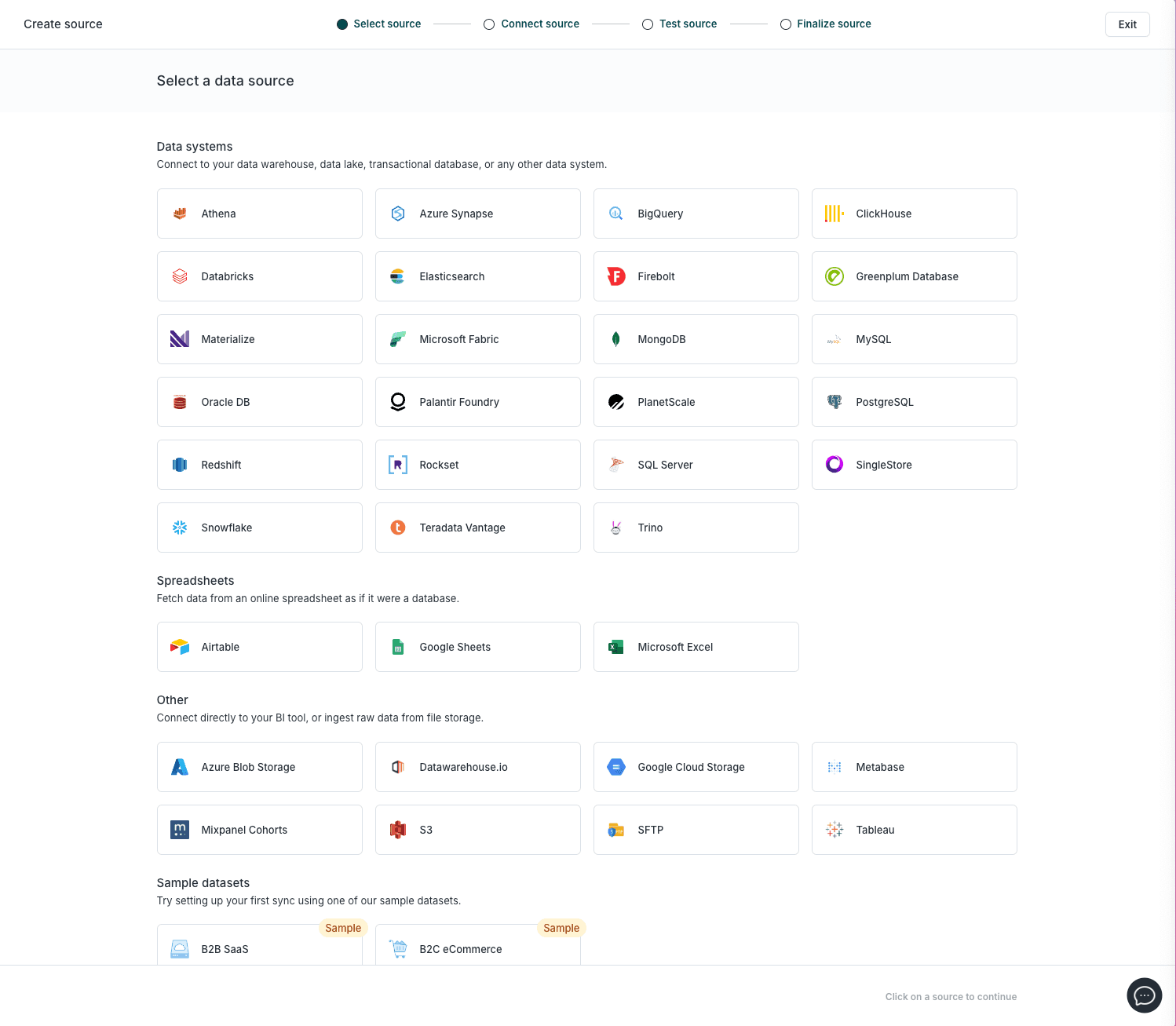
Start by creating a Hightouch account. Once you're logged in:
- Navigate to the Integrations, then Sources.
- Select the data source that contains your event and customer data. This could be a data warehouse like Snowflake, BigQuery, Redshift, or a database like Postgres or MySQL.
- Enter your configuration details, such as credentials and hostnames, to authenticate your data source.
Hightouch will validate your connection and give you access to the schema for building your data model.
2. Define your data model
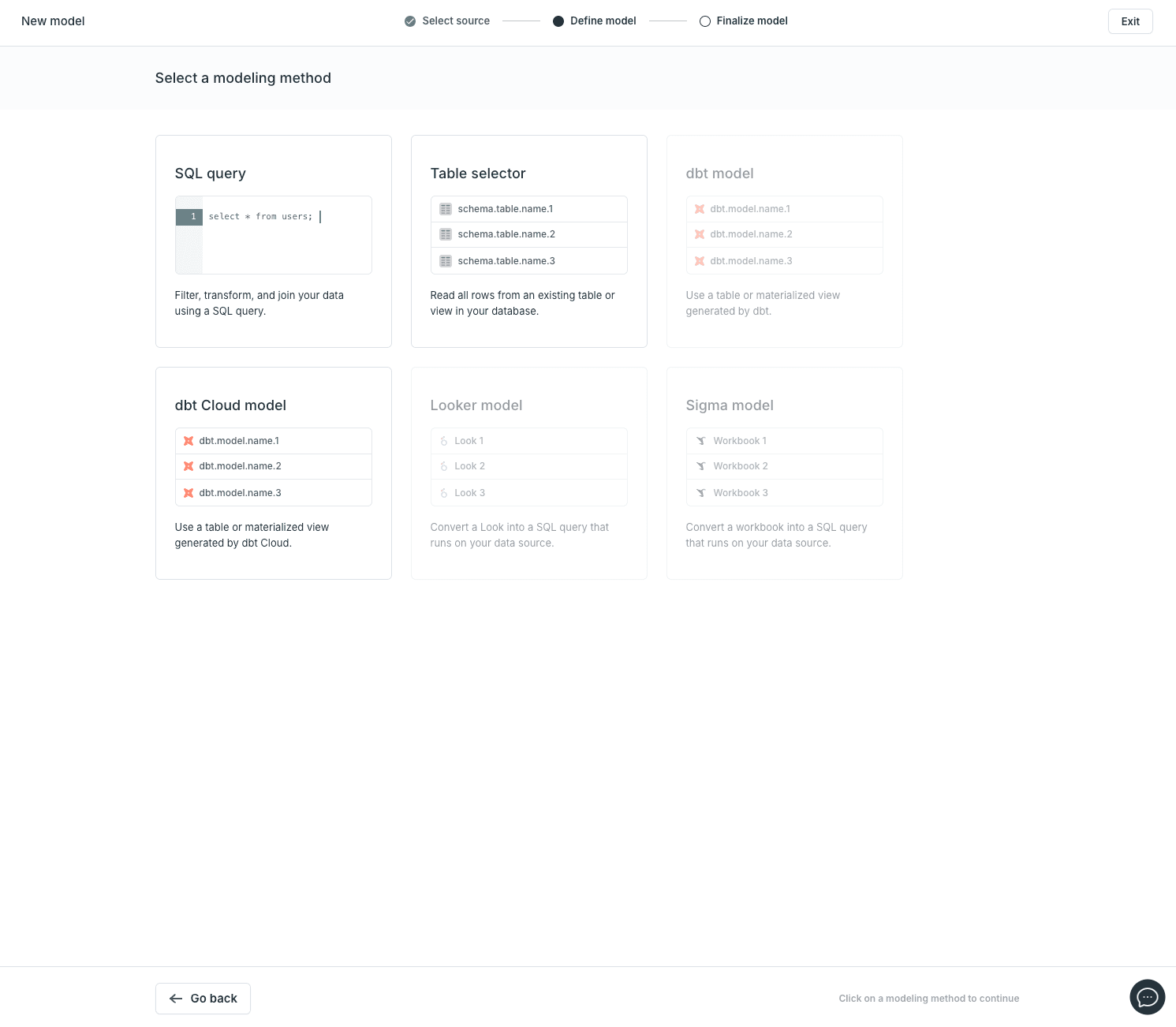
Next, define the event data you want to send to Bing. You can do this in three ways:
- SQL Editor: Write custom SQL to join and transform data for precise control.
- Table Selector: Choose pre-built tables and columns directly without needing SQL.
- Visual Audience Builder: Use a no-code interface to filter and segment your data based on behavior, properties, or timestamps.
This data model acts as the source of truth for what gets sent to Bing. Typical fields include user identifiers (email, phone), event names (purchase, signup), and metadata (value, currency, timestamp).
3. Create a Bing conversion destination
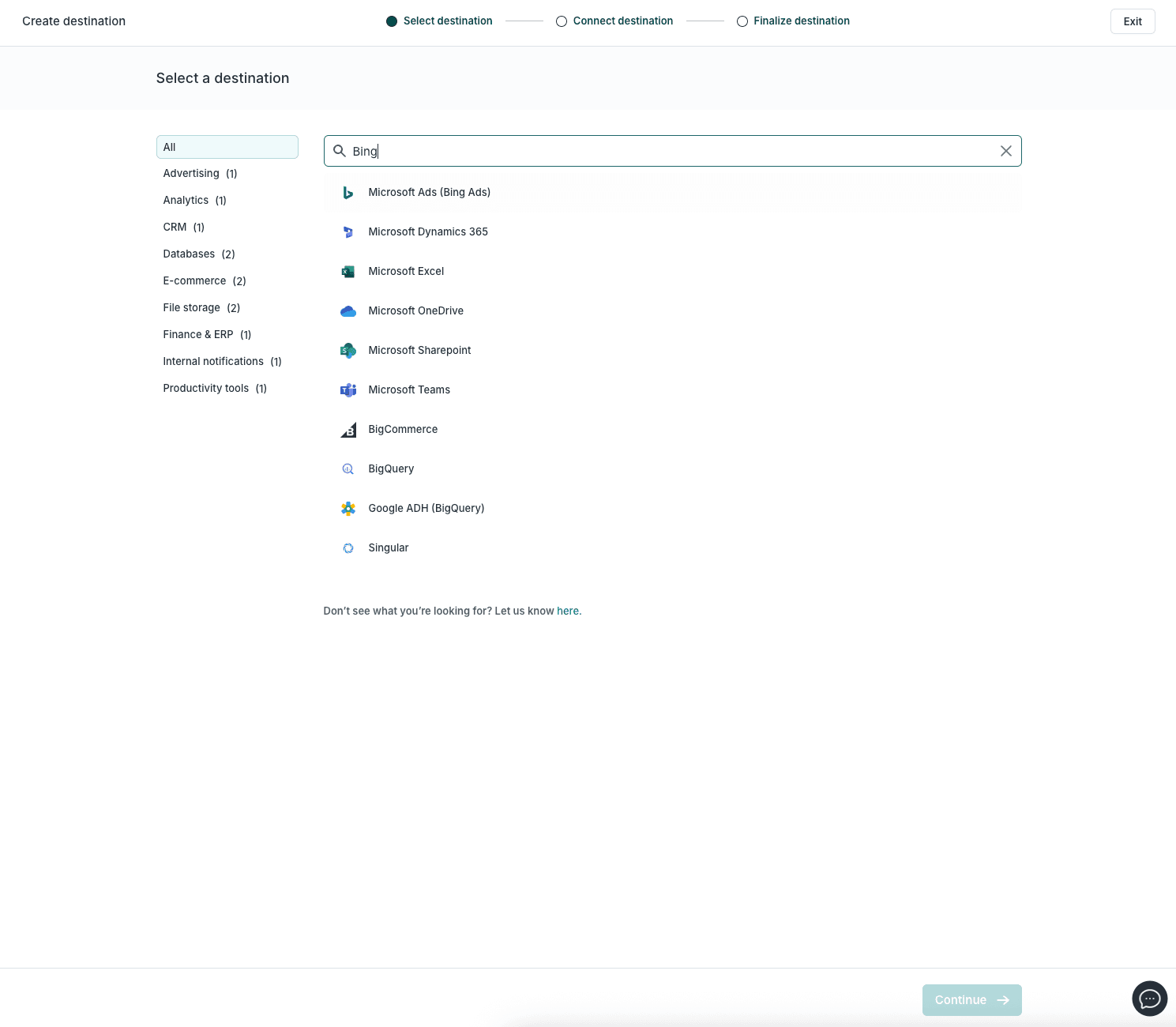
Now it’s time to connect Hightouch to Bing:
- Go to the Integrations, then Destinations.
- Click Add Destination and select Bing.
- Log in to Bing to authorize the connection.
4. Send conversions to Bing
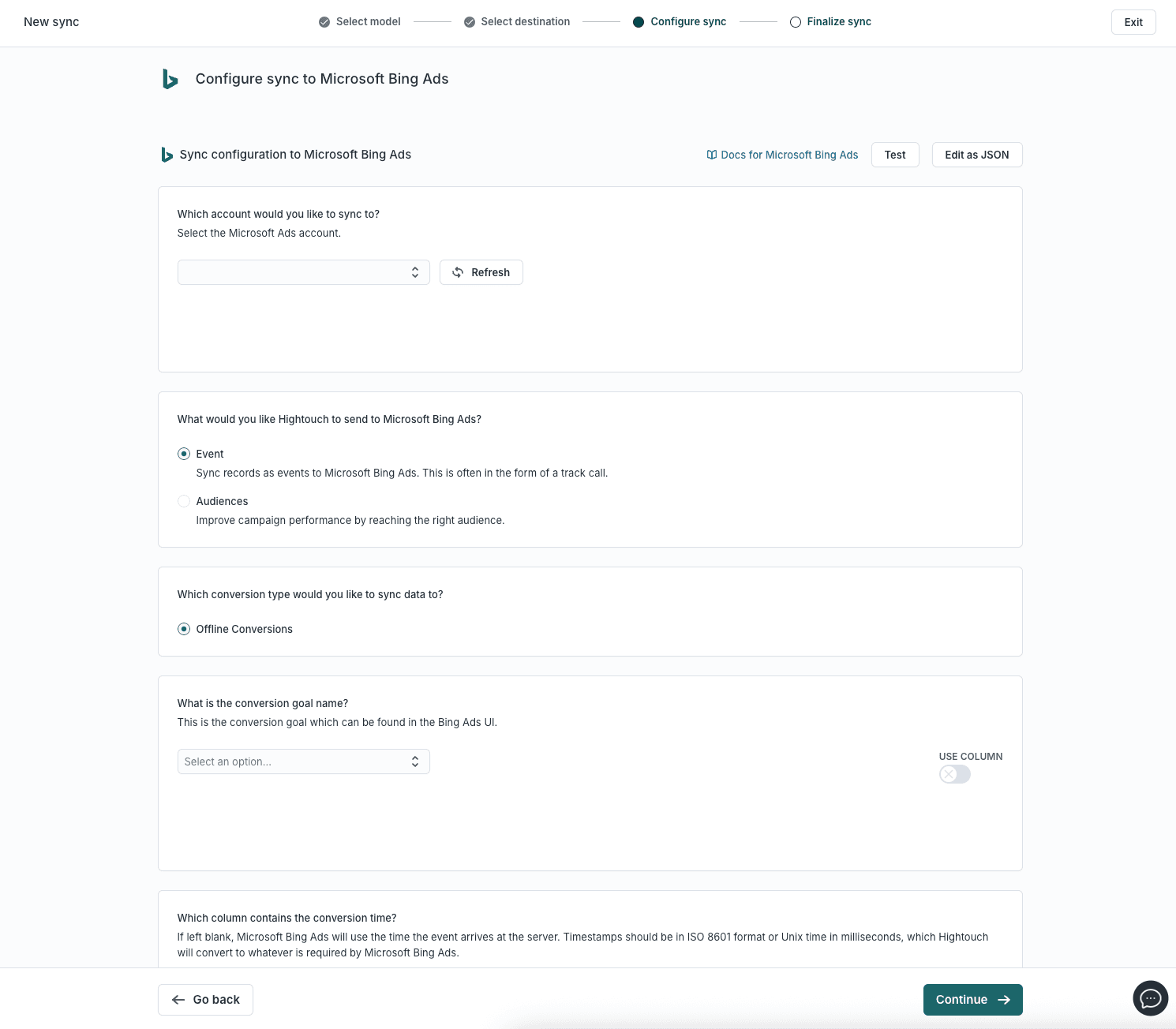
Finally, you’ll configure your sync:
- Got to Activation, then Syncs.
- Click Add sync.
- Choose the model you created and your Bing destination.
- Map the data fields in your model to Bing’s expected parameters
- Run your sync.
What is the Bing conversions API?
The Bing Conversions API (also referred to as the Microsoft Ads Conversions API) is a powerful alternative to traditional browser-based tracking methods like JavaScript tags and web pixels. Instead of relying on scripts embedded in your website that can be blocked or disrupted by browsers, extensions, or operating system-level policies, the Bing Conversions API allows you to send conversion events directly from your server to Microsoft Ads.
This server-side integration gives you complete control over the conversion data you share. It lets you enrich each event with first-party data, such as customer email addresses, phone numbers, or CRM IDs, so you can improve your match rates, optimize bidding strategies, and unlock more accurate attribution. By eliminating reliance on fragile browser mechanisms, the Bing Conversions API helps ensure your most important user actions are reliably captured, measured, and used to drive campaign performance.
Whether you're tracking purchases, lead form submissions, or other meaningful business outcomes, the Bing Conversions API allows you to optimize your campaigns toward the conversions that matter most, even as browser and privacy changes reduce the effectiveness of traditional tracking methods.
Benefits of using Bing conversion API
The Bing (Microsoft Ads) Conversions API offers a more accurate and resilient way to share conversion events with Bing by sending them directly from your server instead of relying on browser-based tracking. This server-side approach enables advertisers to improve performance measurement, strengthen campaign optimization, and maintain data fidelity even as the digital advertising landscape becomes more privacy-conscious and technically complex.
Here are just a few of the measurable benefits advertisers are seeing after switching to the Bing Conversions API:
- Lower your CPR by up to 13%: When your conversion events are sent directly from your server to Bing, you can reduce data loss caused by ad blockers, browser restrictions, or poor network conditions. This improves your signal quality and gives Bing Ads more accurate data to optimize toward, ultimately lowering your cost per result (CPR).
- Increase your attributed purchase events by up to 19%: Server-side events captured through the Bing Conversions API are more resilient to tracking failures and deliverability issues. This leads to a higher volume of successfully matched conversions and allows more of your true impact to be captured and attributed correctly in reporting.
- Boost your ROAS: With cleaner conversion data and more reliable attribution, Bing’s optimization algorithms can better allocate your ad budget toward high-performing audiences, keywords, and placements. This can result in more efficient bidding and a stronger return on ad spend (ROAS) across your campaigns.
- Unlock better measurement and attribution: The Conversions API gives you complete control over what data is shared with Bing, allowing you to enrich events with additional first-party identifiers such as email addresses, phone numbers, or click IDs. This unlocks advanced matching and helps Bing tie events back to users more accurately for improved attribution and reporting.
- Future-proof campaigns against privacy changes: As privacy regulations continue to evolve, client-side tracking becomes more fragile. The Bing Conversions API enables you to maintain performance and compliance by leveraging server-side tracking that is less vulnerable to browser changes, cookie deprecation, and operating system-level restrictions.
What's the difference between a pixel & the Bing conversions API?
Traditional pixels operate within the user’s browser or mobile application. When a user completes an action such as making a purchase or signing up, the pixel automatically fires and sends the conversion event to Bing using browser-based tracking. While this method is simple, it has become increasingly unreliable due to the rise of ad blockers, browser privacy features like Intelligent Tracking Prevention (ITP), and operating system-level restrictions like Apple’s App Tracking Transparency (ATT).
The Bing Conversions API addresses these issues by shifting event delivery from the browser to the server. Instead of relying on client-side scripts, the API allows advertisers to send conversion data directly from their backend systems, such as a CRM, CDP, or data warehouse, to Bing. This server-side approach significantly improves event reliability and data control.
Although slightly more complex to implement, the Bing Conversions API offers enhanced security, greater flexibility, and improved measurement accuracy. Advertisers can enrich their conversion events with first-party attributes, support offline conversions, and ensure compliance with data privacy policies by managing exactly what is shared with Bing.
The table below compares the traditional web pixel with the Bing Conversions API across key dimensions:
| Feature | Traditional Pixel | Bing Conversions API |
|---|---|---|
| Tracking Method | Tracks events using web script or mobile SDK | Tracks and stores events in your internal systems (e.g., CRM, CDP, data warehouse) |
| Delivery Method | Sends events client-side from the user’s browser or app | Sends events server-side directly from your backend systems via API |
| Reliability | Often blocked by ad blockers, cookies, browser limitations, and poor network conditions | Not affected by ad blockers or browser/OS restrictions, enabling more consistent delivery |
| Supported Properties | Generally supports only website-based conversions | Supports both online and offline conversions |
| Privacy & Compliance | Limited control over data sharing and user consent management | Full control over which data is shared and how consent is handled |
| Benefits | Simple to implement and quick to deploy | Offers better performance, more accurate attribution, and improved compliance control |
As data privacy laws evolve and tracking technology shifts, many advertisers are moving away from pixels and adopting Conversion APIs as their default infrastructure. The Bing Conversions API gives you the tools to future-proof your measurement, maintain high-quality data flows, and deliver better campaign results through more reliable conversion tracking.
Why are companies switching to conversion APIs?
Ad blockers, browser restrictions, and operating system policies like Apple’s App Tracking Transparency (ATT) and Safari’s Intelligent Tracking Prevention (ITP) have made client-side tracking methods, such as traditional Bing Pixels, increasingly unreliable. To adapt, Bong and other major ad platforms have introduced server-side Conversion APIs. These allow advertisers to send conversion data directly from their servers, improving the reliability of data delivery and maintaining accurate measurement in a privacy-conscious environment.
- Offline Conversion Tracking: Many businesses are realizing that necessary conversions happen offline. For B2C companies, this might include in-store purchases, while B2B organizations often need to track lead stage progressions in their CRM or offline sales calls. The Bing Conversions API enables these businesses to upload offline events directly to Bing, ensuring these conversions are included in reporting and campaign optimization.
- Advanced Matching: Conversion data sent through the Bing Conversions API can be enriched with first-party attributes such as email addresses, phone numbers, and names, along with system-level identifiers like IP addresses and user agents. This additional context helps Bing better match events to specific users, improving attribution accuracy and enhancing the performance of ad targeting and optimization algorithms.
- Value-Based Bidding: By attaching monetary values to conversion events, advertisers using Bing’s Conversions API can take advantage of value-based bidding strategies. This allows Bing’s ad delivery system to prioritize and bid more aggressively on higher-value conversions, rather than treating all actions equally. As a result, advertisers can increase their return on ad spend by focusing their budgets on conversions that generate more revenue or customer lifetime value.
Bing conversion API use cases
With the Bing Conversions API, advertisers can tailor their data setup and bidding strategies based on their business objectives, whether the goal is more conversions, more revenue, or improved profitability. Below are three core use cases and how they’re typically applied across industries.
Optimize for conversion volume
When the primary goal is to drive as many conversions as possible, regardless of their monetary value, advertisers can configure the Conversions API to send conversion events without attaching revenue data. This setup best suits campaigns focused on volume-based outcomes, such as purchases, form submissions, or demo requests. By omitting values, advertisers allow Bing to treat all conversions equally and focus on optimizing for the lowest possible cost per action (CPA). Bing’s bidding strategies, such as Maximize Conversions or Target CPA, are ideal for this use case and help scale user actions efficiently.
| Industry | Optimization Goal |
|---|---|
| Retail & E-commerce | Maximize the volume of purchase events on the website, in-app, and in-store |
| Media & Entertainment | Maximize the volume of subscription sign-ups |
| Financial Services | Maximize the volume of loan applications submitted |
| B2B SaaS | Maximize the volume of demo requests or product signups |
| Travel | Maximize the number of flights or rooms booked |
| Healthcare | Maximize the volume of health service signups |
| Education | Maximize the volume of enrollments for a course or event |
Optimize for conversion value
For advertisers focused on revenue growth, the Bing Conversions API can be configured to include the gross revenue associated with each conversion event, such as the total order amount or subscription fee. This allows Bing to optimize campaigns not just for the number of conversions, but for their financial value. With this setup, bidding strategies like Maximize Conversion Value or Target Return on Ad Spend (ROAS) become available, enabling more intelligent allocation of budget toward higher-value actions and customer segments. This approach is especially effective when businesses want to grow total revenue rather than just increase traffic or engagement.
| Industry | Optimization Goal |
|---|---|
| Retail & E-commerce | Maximize the gross revenue value of each purchase |
| Media & Entertainment | Maximize the gross revenue from the first subscription payment |
| Financial Services | Maximize the potential value of loan applications submitted |
| B2B SaaS | Maximize the volume of qualified demo requests or product signups |
| Travel | Maximize the gross revenue value of flights or rooms booked |
| Healthcare | Maximize the gross revenue value of health service signups |
| Education | Maximize the gross revenue value of enrollments for a course or event |
Optimize for financial outcome
For businesses focused on long-term value or profitability, the Conversions API can be configured to send the predicted financial outcome of each conversion. This could be based on estimated profit margins, post-cost revenue, or customer lifetime value (LTV). By including this information, advertisers can align Bing’s optimization with tangible business outcomes, such as ROI or contribution margin. Bidding strategies like Maximize Value or Target ROI are most appropriate here, as they help shift the focus from surface-level metrics to the financial impact of each campaign. This use case is especially relevant for companies with longer sales cycles or complex value calculations.
| Industry | Optimization Goal |
|---|---|
| Retail & E-commerce | Maximize the estimated profit of purchases by subtracting COGS, taxes, and fees |
| Media & Entertainment | Maximize the estimated lifetime value of subscription purchases |
| Financial Services | Maximize the predicted value of loan applications submitted |
| B2B SaaS | Maximize the predicted revenue value of demo requests or product signups |
| Travel | Maximize the estimated profit from flights or rooms booked |
| Healthcare | Maximize the gross profit or estimated LTV of health service signups |
| Education | Maximize the gross profit or estimated LTV of course or event enrollments |
What events does the Bing conversions API support?
The Bing Conversions API supports two primary types of events: standard events and custom events. These events track and optimize key user actions across web, app, and offline touchpoints, giving advertisers greater flexibility and accuracy in campaign measurement.
Standard events are predefined by Bing and cover everyday user interactions across industries. Bing’s optimization algorithms recognize these events, which are the most reliable for automated bidding and targeting. They require no additional configuration beyond setup and are ideal for tracking widely used conversion points like purchases, signups, and checkouts.
Custom events, on the other hand, are not predefined by Bing but can be configured by advertisers to represent specific actions unique to their business. These include actions like webinar attendance, content downloads, or in-app milestones. While custom events offer greater flexibility, they may require additional setup and mapping and are generally not as well supported by automated optimization algorithms. For this reason, it's best practice to map custom events to the closest standard event whenever possible to ensure consistent attribution and performance insights.
Below is a breakdown of the event types Bing supports, categorized by their business purpose and optimization goal:
| Category | Event Type | Goal |
|---|---|---|
| Purchase Events | Purchase, Complete Registration, Donate, Place an Order | Track and optimize toward purchases |
| Checkout Flow Events | Add to Cart, Initiate Checkout, Add Payment Info | Track and optimize toward steps that lead to purchases |
| Engagement Events | Customize Product, Add to Wishlist, View Content, Search, Find Location, Click Button | Track and optimize engagement with key actions on your site or app |
| Lead Capture Events | Subscribe, Submit Application, Start Trial, Contact Captured, Lead Captured, Scheduled, Download, Submit Form | Track and optimize toward lead capture |
| Custom Events | Business- or industry-specific actions (e.g., Event Attended, Video Watched) | Track and optimize toward custom conversion events |
These events form the foundation of your Bing server-side tracking setup and allow your advertising campaigns to stay effective even in a world where browser-based tracking is diminishing. Whether you aim to drive more purchases, gather leads, or monitor engagement milestones, using the correct event types ensures more accurate reporting and more intelligent optimization.
FAQS
Where can I access the Bing conversions API?
You can access the Bing Conversions API through Microsoft Advertising's official developer documentation. The documentation includes implementation guidelines, event schemas, and authentication details needed to get started. Depending on your organization’s use case, especially if you’re using offline or advanced custom events, you may need to contact a Microsoft Advertising representative to request access to specific API features or support.
How do I check if the Bing conversions API is working?
To ensure your Bing Conversions API setup functions correctly, you should first check for successful API response codes when sending events. A valid response indicates that Bing has received your conversion data. You can also verify event ingestion through Bing's reporting tools or conversion diagnostics, which confirm whether your server-side events are being processed. Finally, run a test campaign and monitor if conversions are being attributed properly. If no conversions appear despite activity, it could be a result of low match quality, incorrect configuration, or simply that the campaign isn’t converting.
What match rate should I expect from the Bing conversions API?
Match rates refer to Bing’s ability to associate a conversion event with a user or click. These rates can vary significantly depending on the quality, completeness, and accuracy of the identifiers included in your event payload. To improve match performance, enrich your events with system attributes such as IP address and user-agent, customer attributes like email address and phone number, and pseudonymous identifiers such as Click ID (MSCLKID) and Mobile Ad ID. The more attributes you provide, particularly first-party and consented ones, the higher your likelihood of achieving strong attribution and optimization outcomes.
How often should I upload conversions?
For optimal performance, it’s recommended that conversions be uploaded to Bing at least once per day. Frequent uploads help provide Bing’s bidding and optimization algorithms with fresh signals, enabling faster learning and improved campaign responsiveness. Delays in conversion uploads can result in under-attributed performance and suboptimal budget allocation. Wherever possible, automate this process through daily syncs from your CRM, data warehouse, or CDP.
What data should I include when uploading conversion events?
Each conversion event should include key attributes that allow Bing to understand, process, and match the event to users or ad clicks. Here are the four most critical data categories you should include:
- System Event Parameters provide context on what happened and when, such as event name, timestamp, and unique event ID.
- Consent Parameters help Bing determine how to handle data based on user privacy preferences and regional compliance requirements, such as GDPR or CCPA.
- Customer Information Parameters include user-level identifiers like email, phone number, mobile ad ID, IP address, and MSCLKID. These identifiers allow Bing to match conversions to users with higher accuracy.
- Conversion Value Parameters contain monetary details such as revenue, profit, or customer lifetime value (LTV). These values unlock value-based bidding strategies, enabling Bing to prioritize higher-value conversions and optimize for ROI.
All four categories increase event match quality, strengthen attribution models, and improve bidding outcomes.
How long does it take your conversion data to be available in Bing?
While Bing receives conversion data via the Conversions API in real time, it typically takes up to 24 hours for the data to appear in your campaign performance reports. This processing window accounts for event validation, deduplication, and attribution calculations. For critical or time-sensitive reporting needs, it is recommended that you allow at least one full day before evaluating performance tied to newly uploaded conversion events.
Does the Bing conversions API have rate limits?
As with most advertising APIs, rate limits are in place to ensure system stability and fair usage. The specific rate limits for the Bing Conversions API may depend on your account tier, access level, and integration method. While most advertisers will not encounter issues during standard daily usage, those sending high-frequency or high-volume events should review Bing’s API documentation for current rate limits and batching guidelines. You can request increased quotas by working directly with Microsoft Advertising support if needed.




